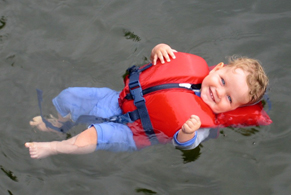Most drowning victims among under 5-year-olds are 2 to 4-year-olds.
Two to 4-year-olds are increasingly mobile as they progress through the toddler years. They are inquisitive and take advantage of their ever-expanding range and speed of mobility. They have no awareness of looming aquatic danger. It is up to parents and caregivers to protect them. Toddlers and children under 5 are at risk when they are playing near water - far and away the activity most involved in toddler drownings.
Private backyard pools present the greatest danger at this life stage, accounting for one-third of water-related deaths for young children under 5 years, although beaches and waterfronts on lakes and rivers also contribute.
By far the biggest risk factor for young children is lack of supervision from parents or caregivers. Almost all these young victims were alone when they became immersed in water. The lapse in attention may have been just a few moments, but it was fatal.
Drowning prevention tips
If you're not within arms' reach, you've gone too far.
Drowning is a silent killer and can happen in as little as 10 seconds. Parents and caregivers must be near (within arms' reach) their children whenever they are near water - in the backyard, at the beach, and in the bathroom. Stay tub-side until the water is drained and children are out of the tub. Most bathtub drownings occur because children are left alone "just for a moment."
Restrict and control access to the water.
Many toddlers who drown do so because they unexpectedly gained access to the water - the backyard pool, the lake or the bathtub. Typically, human error leads to a gate or door being left open or a lock unsecured.
Layers of protection will reduce the chance of human error. If you can't eliminate the water hazard, restrict access to it by fencing off natural or man-made bodies of water on your property and ensure that gates are self-closing and self-latching. Drain bathtubs when not in use, and empty unattended wading pools and buckets of water and turn them over.
Designate a backyard pool lifeguard.
An adult must always supervise children using a pool - in-ground, above-ground or wading pool. If one adult must be absent for a moment, designate a replacement or close the pool until someone can assume supervisory duties.
:::

Wear a lifejacket.
As an extra layer of protection, put toddlers in a lifejacket when they are near water. Lifejackets do not replace attentive supervision, but will keep a toddler at the surface - which may give parents the seconds they need to save a life.
Go to lifeguard supervised beaches and pools.
For safer play near the water, take children to beaches and pools supervised by certified lifeguards. Lifeguards do not replace direct parental supervision but act as an extra layer of protection.
Parent & tot aquatic programs.
A positive introduction to water can give your child a lifetime of pleasure swimming. Toddlers are particularly suited to get used to the water with their parents in an instructional setting.
Infant "self-rescue" swimming lessons are not recommended or supported by the Lifesaving Society
Media buzz around these types of swimming courses, intended to "safeguard" infants against drowning, have no scientific research backing them. However, there is research warning against it.
Drowning can happen regardless of how comfortable your child or infant is in the water - no one can be truly "drown proofed." What you can do is restrict your child's access to water and be there - within arms' reach - and with your eyes on your child at all times.
An infant may learn in a controlled environment to roll onto their back in the water; they may be able to kick their legs and cry while floating at the surface. When parents see this they are lulled into a false sense of security and become overconfident and less diligent in their parental duty to restrict their child's access to water.
Research from the Canadian Pediatric Society explains: "There is no evidence that swimming lessons prevent drowning or near drowning in this age group (two to four years of age). Although it may be possible to teach young infants basic motor skills for water, infants cannot be expected to learn the elements of water safety or to react appropriately in emergencies. No young child, particularly those who are preschool aged, can ever be considered water safe."
The Lifesaving Society supports swimming lessons for pre-school aged children that promote water safety aimed at parents, develop basic motor skills for children and familiarize children with the water. The Lifesaving Society does not support swimming lessons that imply an infant or child will be "drown-proofed" - there is no such thing.
We encourage parents and caregivers to remember that drowning is the second leading cause of accidental death for children under the age of five. In most of these cases there was a momentary lack of parental supervision. Drowning is preventable. Parents and caregivers are responsible to safeguard their children from drowning by taking the appropriate measures:
- Restrict and control access to water
- Backyard pools should have four-sided, self-latching fencing to prevent children from gaining access
- Children should be within arms' reach of an adult, who has their eyes on that child AT ALL TIMES when near the water
- Bathtubs should be drained, toilets seats closed and latched, and any instances of standing water removed
- Children who cannot swim should always wear a lifejacket
- Parents should not expect infant "survival" swimming lessons to protect their children, and should remain vigilant about water safety
- Remember, drowning is silent and can happen in mere seconds